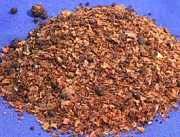Previous Page | Right click this page to print.
Distillery and Brewery By-Products
Distillery and brewery by-products are another group of plant-based high protein feedstuffs. Distillery and brewery by-products are fed dried, wet, or ensiled. Grain sorghum-based by-products are also available. The nutritional value is similar to the corresponding corn-based product.
Distillery by-products are the high protein residues following the distillation process. The materials of the distillation process include water, grains, malt, and yeast. In the first step, the grains and the water are cooked. Then, the malt is added to facilitate enzymatic degradation of carbohydrates. Then, yeast is added and the mixture is fermented. Following fermentation, the alcohol is removed via distillation and the remaining product is known as whole stillage. Whole stillage is further processed to produce the distillery high protein by-product feeds. The most common distillery high protein by-product feed is distiller's dried grains.
Figure 6.15 illustrates distiller's dried grains.

Additional distillery high protein by-product feeds include condensed and dried distiller's solubles, distiller's dried grains with solubles, and distiller's dried yeast. As alluded to, generally, the products are dried prior to feeding. The specific distiller's dried grains will be named according to the predominant grain in the by-product feedstuff. For example, corn is the predominant grain in the corn distiller's dried grains.
Distillery by-product feeds are high in protein. The average crude protein content of distillery by-products is 27-29% on an as-fed basis. Distillery by-products are low in lysine and phenylalanine. Distiller's solubles have a better amino acid profile compared to the other distiller's by-products. Distillery by-products have a moderate to high energy content. Distiller's grains have a higher fiber content than the other distillery by-products. Distillery by-products also have high contents of B-complex vitamins, phosphorus, sulfur, and some of the microminerals.
Brewery by-products are the residues following beer and ale production. The first step in production is the barley is malted. Water is added to the barley and the barley is allowed to germinate and subsequently the carbohydrates are degraded. Then, the sprouted barley is dried. Malt sprouts and malt hulls are removed. Additional grains, hops, and water are added to the cleaned grain and the mixture is cooked. Following cooking, the liquids or wort are separated from the solids. The liquid is then fermented. The major brewery high protein by-product feeds include brewer's dried grains, brewer's dried malt sprouts, and brewer's dried yeast. Additional high protein by-products from the brewery industry include brewer's dried spent hops and brewer's condensed solubles.
Grains and malt sprouts have a crude protein content of 26-29% on an as-fed basis. In addition, the protein is of good quality. The limiting amino acid in dried grains and malt sprouts is lysine and methionine, respectively. Brewery by-products are relatively high in tryptophan. Grains and sprouts have a high fiber content. The crude fiber content of grains is 18-19% and sprouts is 14-16%. The crude protein content of brewer's yeast is 45% crude protein on an as-fed basis. Yeast is high in lysine, tryptophan, and the B-complex vitamins.
The feeding recommendations for distillery and brewery by-products vary with by-product and by animal species. In general, the distillery and brewery by-product feeds are a more favorable feed for ruminants than for monogastrics. Distiller's and brewer's grains are primarily fed to ruminants. Distiller's and brewer's grains are a good source of rumen inert protein. Condensed distiller's solubles and distiller's grains with solubles are fed to ruminants and may also be fed to monogastrics in limited amounts. Brewer's malt sprouts are typically fed to ruminants also. Brewer's yeast may be fed to both monogastrics and ruminants.
Previous Page | Right click this page to print.